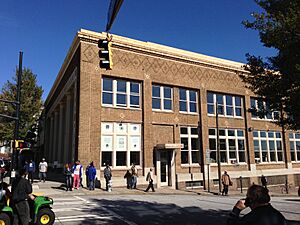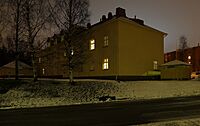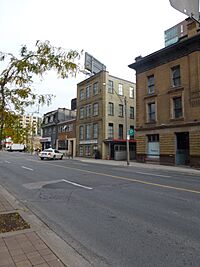Homeless shelter facts for kids

Homeless shelters are places that offer a temporary home for people and families who don't have a permanent place to live. These shelters keep people safe and protected from bad weather. They also help reduce the impact of homelessness on the community. Shelters are different from emergency places set up for specific events, like after a natural disaster or for people escaping difficult home situations. During very cold or hot weather, special "warming centers" or "cooling centers" open for short times to help people stay safe.
Contents
Who are Homeless People?

Health Challenges
Sadly, many homeless people get sick or even die each year. This can be from diseases, untreated health problems, not enough food, or being exposed to very cold or hot weather. For example, in New Orleans after Hurricane Katrina in 2005, about 10,000 homeless people were not found.
People staying in shelters can also face issues like bed bugs or roaches. Researchers have found that homeless people often have a higher risk of breathing problems, skin issues, and infections. This is because of living on the streets, not having good food, or not being able to clean themselves easily. Being in crowded places can also spread germs. Besides physical health, homeless people can also struggle with their mental health.
During the COVID-19 pandemic in 2020, shelters were advised to work with their communities to share important health information and keep everyone safe.
Men Experiencing Homelessness
In the United States, studies show that about two-thirds of homeless people are men. Most of these men are single adults between 25 and 54 years old.
Poverty can really affect a man's health and lifestyle. It can lead to low self-esteem, feeling weak, mental stress, and poor physical health. Even though women often face higher rates of poverty, men still experience these negative effects.
Women Experiencing Homelessness
Women are at a higher risk of becoming homeless or living in poverty, often because they are the main caregivers for children.
Homeless women, whether they have children or not, tend to have more physical illnesses than men. They might also feel very stressed and always on alert. Women looking for safety from difficult home situations sometimes struggle to find space in shelters.
Different Ways to Help
Housing First
Many homeless shelters are set up for emergencies and can only help a small number of people. The "Housing First" idea offers a different approach. This program focuses on the big problem of not having enough affordable homes. It tries to help homeless families move into their own homes as quickly as possible.
Housing First has been successful because families are more open to getting help once they are in their own place. The program offers quick support, affordable rent, and social services for about six months to a year. This grace period helps families get back on their feet. The idea is to help families figure out what they need and make good choices for themselves, so they can plan to live on their own.
Religious Shelters
Some shelters are run by religious groups. For example, the Rescue Mission in Milwaukee, Wisconsin, helps homeless people through Christian faith. To get a free meal there, people might first attend a Christian prayer service. The Salvation Army is another group that offers social support and is also a religious organization.
Cars as Homes
Around the late 2000s, in places like Santa Barbara and other areas in California, some people who had recently become homeless started living in their cars in parking lots. They often got help from local non-profit groups. These individuals and families couldn't afford rent or a mortgage, but they still had jobs, cars, and insurance. In Santa Barbara, about 55 people slept in cars each night in different private and public lots. Some lots were just for women.
As more people started living in their vehicles, some California cities passed laws against sleeping in cars. However, many of these laws were later found to be unconstitutional by higher courts. In Los Angeles in 2015, about 9,500 homeless people were using their cars as homes. In Hawaii, a company in Honolulu is turning old city buses into mobile shelters that offer a place to sleep and shower.
Community Views
People's opinions about homeless shelters can be very different. One study found that older people, men, homeowners, and those with higher incomes were often not in favor of shelters being near their homes. In Calgary, neighborhoods understood the need for shelters but didn't want them close by. A similar feeling was found in Oahu.
However, in places like Portland, Oregon, which has harsh weather, there is a strong network of supporters. They run a cafe called "Sisters of the Road" that helps both shelter residents and people living on the streets. On the other hand, in places like Santa Barbara, California, there are often disagreements about shelters. Sometimes, city benches have even been changed to discourage people from asking for money.
Sometimes, people worry about diseases spreading in shelters. But public health experts say these worries are often too big. A study in Marseille, France, in 2014, found that breathing illnesses in homeless shelters were not much different from the general public. Also, during flu season, shelter residents didn't test positive for the flu virus. However, there were reports of tuberculosis outbreaks in shelters in three large Ohio cities in the 1990s.
A question has also been raised about how much money donated to charities that run shelters actually reaches the homeless people and the services they need. Sometimes, a lot of the money goes to administrative costs instead.
Inside Shelter Problems
Sometimes, there have been issues like theft by shelter employees. For example, in 2011, a TV report in Boston found that some public shelter employees were stealing large amounts of food from the kitchen for their own use. Residents have also reported that their personal items were stolen by other residents.
Shelters can become very crowded if too many people are allowed in. Also, some shelters might not meet state safety rules, like checking fire sprinklers or making sure exits are clearly marked. In New York City in 2015, the state stopped funding many shelters that didn't meet these standards or had poor conditions.
Shelter employees can sometimes face violence from the people they are helping. To make things safer for employees in New York, the Department of Homeland Security increased security at some shelters in 2015. Many employees know there are risks, especially when working in certain neighborhoods or with people who have mental health issues. But they continue to work because they feel they are providing an important public service, like the police or firefighters.
Outside Shelter Problems
When a homeless shelter is nearby, some problems can come up. Businesses have sometimes complained that homeless people stop pedestrians outside their stores to ask for money. This has led to local laws against "aggressive panhandling." Another challenge is deciding where to build a new shelter and how to zone the area around it.
Some neighborhoods and schools argue that homeless shelters bring unwanted elements to their surroundings. They might also feel that shelters don't offer enough job training or education to help homeless people find their own housing.
Shelters Around the World
Australia
In Australia, most homelessness services act as both daytime and nighttime shelters. They offer "wrap around" services, meaning they help residents with many things, like case management, to become independent. An example is Najidah.
Youth refuges in Australia provide a safe place for young people in crisis and help them learn to live on their own. These refuges are a newer type of homeless shelter. Some of the first ones in New South Wales, like Caretakers Cottage, started in the mid-1970s.
Canada
Canada had an estimated 150,000 to 300,000 homeless people in 2014. Canada has increased the number of shelter spaces to help with this. A study in Canada also found that people entering shelters sometimes felt a loss of their own identity. A type of therapy called "Therapeutic Conversation" has been successful in Calgary in helping a small group of shelter residents improve their mental health. Calgary has seen more homelessness partly because there aren't enough affordable rental homes.
A volunteer group in Canada called Angels in the Night donates warm clothes and other supplies to homeless people. They visit shelters and people on the streets. In 2015, Clean the World started a center in Montreal to provide soap for homeless shelters. This group recycles hygiene items like soap and shampoo.
China
In China, it's hard to get exact numbers for homeless people because the government doesn't count those in temporary shelters as "homeless." There might be about 1 to 1.5 million homeless children who have left their families due to extreme poverty, family problems, or abuse.
Homelessness in China is mainly caused by natural disasters, people moving to new areas, and unfair treatment. Natural disasters often force many people from their homes. Unlike other countries, China has a very high number of homeless children. About half of these children are runaways trying to escape difficult homes. During the COVID-19 pandemic, the number of homeless people grew because of China's strict lockdown rules. Many essential workers, like delivery people, couldn't go back to their homes and became "homeless" because of the risk of spreading the virus. In Shanghai during the pandemic, nearly 20,000 delivery riders faced a lack of shelter.
In 2014, a government-supported shelter in Henan province, which housed 20 homeless people, was criticized for tying children to trees and having poor sleeping areas.
India
India defines homelessness as not living in a "census house," which must be a building with a roof.
In India, young people can become homeless if they are abandoned. Young people in Jammu and Kashmir who lived in shelters reported experiencing emotional and physical abuse and neglect while there.
Homeless individuals and families in India often struggle to get clean water and hygiene services. A 2011 Census found that while most urban areas had access to safe drinking water (91.9%) and sanitation (81.4%), there's a big lack of housing in major cities. People from rural areas come to cities looking for work, and if they can't find housing, they often build their own shelters, sometimes called "hutments."
Homelessness in India
According to the 2011 Census, there were 1.77 million homeless people in India, which is about 0.15% of the country's total population. The cities with the most homeless people in India are Greater Mumbai, Delhi, Kolkata, Chennai, and Bangalore.
Iran
Tehran, the capital of Iran, has three shelters for men and one for women, with space for about 4,000 people. Other cities like Qazvin, Sanandaj, and Zahedan have two shelters each. Isfahan has one large shelter with 5,000 beds. These shelters are mostly run by charity money or non-profit groups. Homeless people can usually stay for one to two days. Social workers might help at these shelters.
Japan
In Japan, about 25,296 homeless individuals were counted in 2003. The number of people without homes has been growing a lot since the "bubble economy" ended in the 1990s. In Tokyo around 2007, many homeless people were moved out of their temporary homes in city parks. In 2011, a big earthquake and tsunami left many people homeless and living in shelters.
United Kingdom
In the United Kingdom, "sleeping rough" means sleeping without shelter. Not all homeless people are automatically given housing. Shelters like 'Jimmy's' in Cambridge offer temporary places to stay and support services in the basement of a Baptist church. This helps people who would otherwise be "sleeping rough."
United States
In the United States, the "shelter movement" grew a lot in the 1970s. This was when many people were unemployed, housing costs were rising, and people with severe mental illnesses were leaving hospitals. By the 1980s, homelessness became a big problem, and professionals created shelters as "temporary safe places." The number of people in shelters more than doubled by the late 1980s and again by 2000. In January 2010, about 407,966 people were staying in shelters, transitional housing, or on the streets.
Homeless shelters need to offer many different services to the people who stay there. Some shelters, like La Posada Providencia in San Benito, Texas, also house asylum seekers from places like Mexico, Central America, and South America. Shelters also reach out to people who can't or choose not to use a shelter.
Most shelters usually expect people to leave in the morning and return for an evening meal and to sleep. During bad weather, shelters might offer services for longer hours.
The Department of Housing and Urban Development (HUD) estimates that about 5 million Americans qualify to use homeless shelters. As poverty increases, the number of shelters, especially in the United States, is expected to keep growing. A study of 24 U.S. cities found that people stayed in shelters for about seven months on average each year.
Homeless camps have become common in US cities, especially where many homeless people are visible, like Seattle and San Francisco.
Homelessness in the United States
A study by the National Law Center on Homelessness and Poverty estimates that 2.3 to 3.5 million Americans experience homelessness each year. Alaska, California, Nevada, Oregon, Colorado, and Hawaii have the highest numbers of homeless people. About 1.5 million children, or one out of every 50 children in America, are homeless.
Many Americans experience "chronic homelessness," which means they have a long-term health condition and have been homeless for over a year, or for at least four times in four years. About 23% of homeless people are considered "chronic homeless." Veterans make up almost 40% of homeless men in the United States.
Here's a look at the different groups of people experiencing homelessness in the United States:
- White people: 39%
- African-Americans: 42%
- Hispanic people: 13%
- Native Americans: 4%
- Asian people: 2%
About 40% of all homeless youth in the United States identify as LGBT (Lesbian, Gay, Bisexual, Transgender). In San Francisco, about 29% of all homeless people in that city are LGBT. The National Center for Transgender Equality reports that 1 in 5 transgender individuals has been homeless at least once.
Some homeless people have pets. Estimates show that about 5 to 10 percent of homeless people in the United States have a pet.
Homelessness is mostly found in cities. Central cities have 71% of the homeless population, while suburbs have 21%. Only 9% of homeless people live in rural areas.
How Shelters Work in the U.S.
Shelters that receive money from the United States Department of Housing and Urban Development (HUD) usually require people to have identification.
Groups Helping Shelters in the U.S.
Several national organizations in the United States help create and support homeless shelters:
- National Alliance to End Homelessness
- The Salvation Army
- The Department of Veterans Affairs
- Covenant House
- Feeding America
Libraries and Shelters in the U.S.
Homeless shelters often work with other groups, like libraries, to help people. They might work together to give temporary library cards to shelter residents. This allows new users to use computers, books, and other library services.
Government Help Programs in the U.S.
HUD estimates that it costs about $60,000 each year to house a homeless family in a shelter. Because of this, HUD has programs to help families, such as "rapid rehousing" and permanent housing "voucher"s (like coupons for housing). Housing vouchers from HUD are very important for preventing families with children from becoming homeless and for helping them leave the shelter system for good.
See Also
- Civil defense
- Cooling center
- Emergency management
- Extreme poverty
- Food bank
- Four penny coffin
- Homelessness
- Human rights
- Penny sit-up
- Refugee camp
- Right to housing
- Social programs
- Soup kitchen
- Warming center


